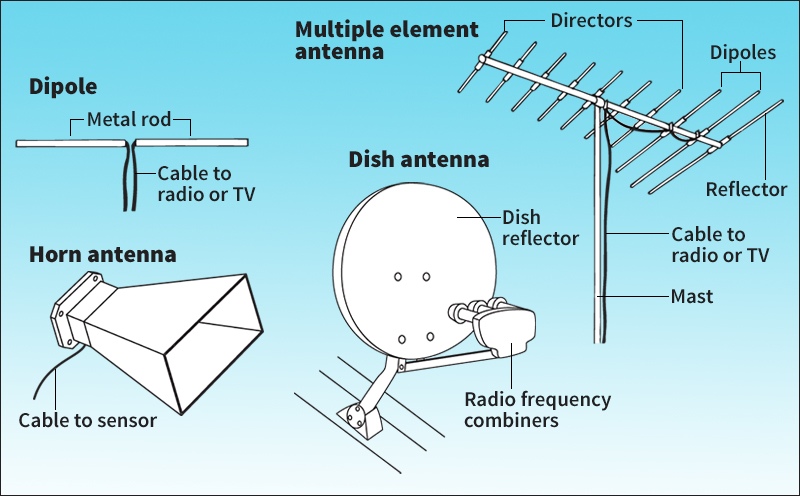Antenna is a device used in an electronic system to help information pass from a transmitting location to a receiving location. An antenna takes in or sends information in the form of waves of energy, known as electromagnetic signals, via cable, wire, the air, or another medium. Antennas are used in nearly all electronic communication and navigation systems.
The signals sent out from an antenna travel via a carrier wave. The frequency of this wave is called the center frequency or carrier frequency. The wave begins as a continuous wave pattern but is modulated (altered) in one or more of three ways to include a representation of the information. The three main forms of modulation are amplitude, frequency, and phase. In amplitude modulation (AM), changes in the amplitude (strength) of the carrier wave represent the information. Frequency modulation (FM) varies the number of cycles per second of the carrier wave (see Frequency modulation ). Phase modulation (PM) alters the phase (timing) of the carrier wave. In PM transmissions, the relative starting point of the carrier wave periodically readjusts as signals fall out of phase.
Antenna systems are designed with different directivities—that is, they do not all send out or pick up signals equally in all directions. A radar antenna, for example, transmits electromagnetic signals in a narrow beam and in a specific direction. On the other hand, an antenna in a Global Positioning System (GPS) receiver must be able to receive signals from any of several navigation satellites in orbit above Earth.
Types of antennas.
Different applications require different types of antennas. The length of a resonant antenna is proportional to the wavelength of its system’s center frequency. Resonant antennas include dipoles, monopoles, and patch antennas. A dipole consists of a straight metal rod or wire that is split in the center. A monopole is simply a straight metal rod or wire. A patch antenna is basically a flat square of metal foil. Resonant antennas are inexpensive to produce, and they can receive from, and transmit to, a wide area. They are used in such devices as cellular telephones, wireless computer network equipment, and GPS navigation systems. A resonant antenna is physically small when its system’s center frequency is high.

Electrically short antennas are antennas that work well for low-frequency applications. Such applications include long-range communication, commercial broadcasting, and navigation. Aperture antennas are often shaped like horns. They are typically used in directional high-frequency applications, as in police radar systems for measuring the speeds of automobiles. Dish antennas are somewhat bowl-shaped. Their uses include relaying electromagnetic signals to and from artificial satellites. One well-known purpose of dish antennas is to receive television programming from satellites in geostationary orbit, an orbit that matches the rate of rotation of Earth. Another is to communicate with deep-space probes. Array antennas combine two or more specially positioned antennas that vary in amplitude, phase, or both, to increase the overall performance.
History.
Heinrich Rudolf Hertz, a German physicist, invented the first antenna around 1887. In the early 1860’s, James Clerk Maxwell, a Scottish scientist, had predicted the existence of electromagnetic waves that can travel through space. Hertz used his antenna to confirm Maxwell’s prediction. Hertz’s device was able to transmit and receive radio waves, a type of electromagnetic signal.
See Radar (The antenna) ; Radio (Transmitting radio waves) .
